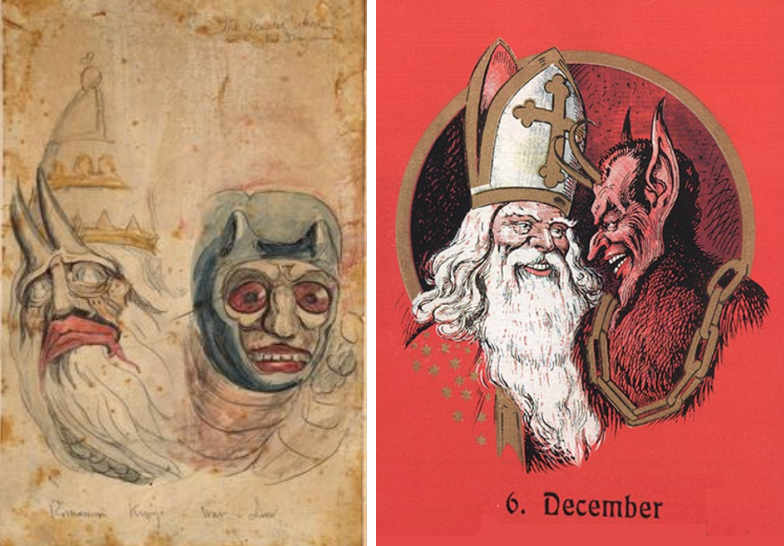I speak from my own perspective of course, but isn’t Christmas a bore these days? Spending time with family and loved ones is wonderful for most, but sanctioning it as an official holiday has become tedious, draining and for many that have ‘woken up’ to the ‘reality of ‘reality’, just another focus for an ‘energy theft’ that has no bearing on the real plight of humanity today. It’s the perfect example of Ground Hog Days… Now before anyone says ‘Ba humbug’ (which is a word incidentally that means to act in a ‘deceptive’ or ‘dishonest’ way), I will say that there is a meaningful connection to the ‘introspection’ at this ‘time of year’. The winter period brings ‘clarity of focus’ for those that can look within. Being creative is important too as winter kicks in, but the modern day version of what was ancient Saturnalia is nothing more than a ‘massive energy grab’ (our human energy) just as it always was.
What’s that old saying, ‘when in Rome, do as the Romans do? We do and Saturnalia is now officially here once again.
The ‘Time’ when Ancient Rome Comes to Town
On one level, Saturnalia was a ’festival of light’ in Rome, leading through to the Winter Solstice (21st December), signified through an abundant presence of candles (fairy-lights) and pine trees. All of which are meant to be symbols of our quest for ‘knowledge and truth’ (light) at the darker end of the year. The other aspect of Saturnalia is more about the ‘giving and ‘taking’ of energy. However, when you look around our modern day 21st century ‘Saturnalia fest’, I think its safe to say that the ‘knowledge and truth’ has taken more of a back seat. The whole period of ‘time’ called Christmas can be an ‘unnecessary burden’ for too many and it also focuses our energy on the ‘polarisation’ of those that ‘have’ and those that ‘don’t have’. It’s magnified at this time of year, especially when we see the rich, the famous and the ‘gods of our time’ (celebrities) revelling in Saturnalia. The amount of presents being bought in some homes and the over indulgence by those that have discovered their ‘credit cards power’ of no return is beyond madness in my view. As Asterius wrtites in Oratio 4: Adversus Kalendarum Festum;
“This festival teaches even the little children, artless and simple, to be greedy, and accustoms them to go from house to house and to offer novel gifts, fruits covered with silver tinsel. For these they receive, in return, gifts double their value, and thus the tender minds of the young begin to be impressed with that which is commercial and sordid.”
If anything, Christmas (Saturnalia) can bring heightened emotions, stress, arguments, loneliness, drunkenness, suicide and the overpowering need to ‘keep on with the programme’ called Christmas. ‘Boxing Day’ in the UK can take on a very literal meaning for some. I know Christmas also brings laughter, love and hapiness too, which is why it has ‘two sides’. Christmas shopping, Black Friday’s, the sales, buying things and maxing up debt has become the norm for people that have ‘bought into’ the vibe of modern Saturnalia. When I was a kid people used to stock up on food at Christmas like there was going to be a war? Bread was frozen in quanties across homes all over Britain in the 80’s as though there was going to be a famine (the shops really did close for days back then). To understand the Christmas ‘vibe’ we have to go back in time to ancient Rome.
Inner Light – Outer light
Saturnalia is/was the Roman festival of the ‘renewal of light’ and the coming of the ‘new year’, celebrated as the Dies Natalis Solis Invicti, or the birthday of the ’Unconquerable Sun’. The date for this event was the 23rd of December, but the roots of this go further back into the ancient world and have more meaning in the attachment to Saturn (the Old Sun), and not necessarily the Sun. Of course the birth of the new ‘Sun (a Son) god was interchangeable with the ‘Son of God’ (born on the 25th of the month), not least thanks to Emperor Constantine… The rest is fable disguised as history. In 4th Century Christian leaders succeeded in converting to Christianity large numbers of Roman pagans by promising them that they could continue to celebrate the Saturnalia as Christians. The problem was that there is nothing very ‘Christian’ as such, about Saturnalia. The Jewish festival of Hanukkah (with its 9 to 8 candles) is another Saturn based focus at the same time of year.
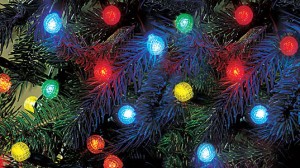
Saturnius Mons – Lord of the Golden Age
The oldest Roman religious calendars, which were thought to have been established by the legendary founder of Rome, Romulus and his successor Numa Pompilius, marked Saturnalia (Saturnius Mons) as a legal holiday in December. The 19th of December marked the dedication anniversary (dies natalis) of the Temple to Saturn in the Roman Forum in 497 BC (see below). Julius Caesar had the calendar reformed because it had fallen out of synchronization with the solar year, two days were added to the month, and Saturnalia then fell on 17th December, through to the 24th of December – Candle-mass Eve.
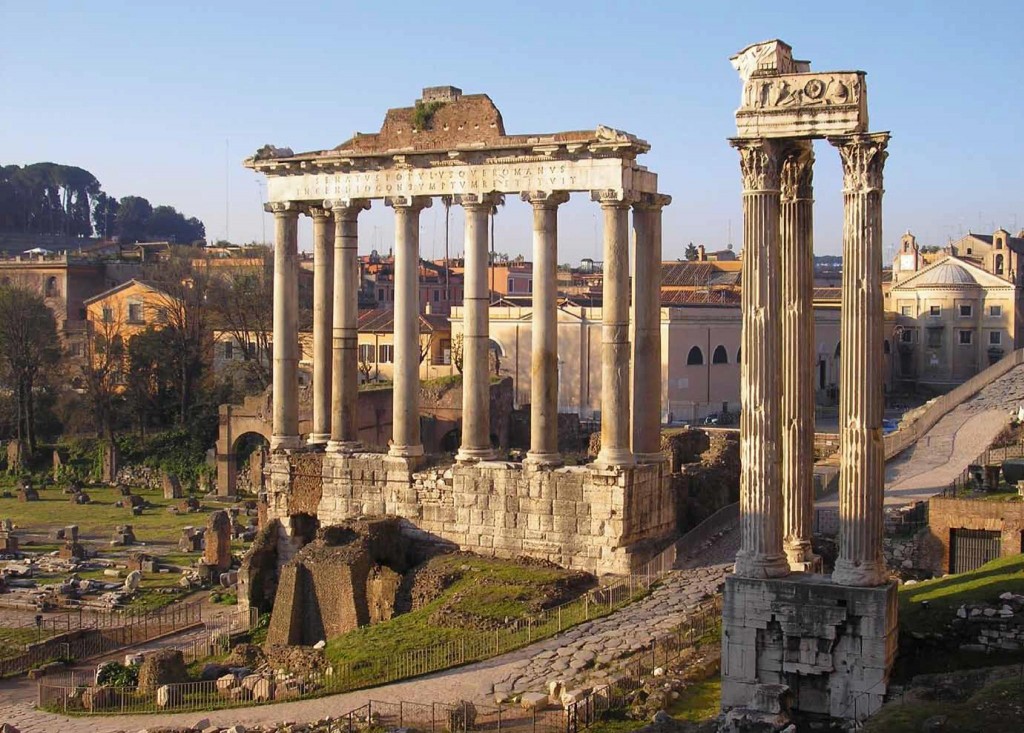
In Roman mythology, Saturn was an agricultural deity who was said to have reigned over the world in the Golden Age, (most likely a pre Atlantis world), when humans enjoyed the spontaneous ‘bounty of the earth’ without ‘labor’ and in a ‘state of innocence’. Any chance of that Golden Age now would be fine thing? Saturn was the first god of the Capitol, known since the most ancient times as Saturnius Mons, and ‘he’ was seen as a god of generation, dissolution, plenty, wealth, agriculture, periodic renewal, law and liberation. The death of a Sun and the ‘birth of a Sun’ (its light) are embroiled in the symbolism of Saturnalia. So are the notion of ‘old and young’, ‘Santa and children’ and the gifts given through life itself. Life is ‘given to death’, so that ‘death can live’. The BBC’s Children’s drama The Box of Delights in the 1980’s is another fine example of the symbolism evoked through Saturnalia. The ‘box’ or cube is another symbol of Saturn. See the images below.


In many ancient beliefs, the Sun (Saturnis Mons) was used as a marker for when the position of the Sun (as seen from Earth) would change simply to ‘mark’ lighter nights, darker days (solstices) and it is all based on the over arching mechanism of marking ‘time’. Who was the Lord of time? The old bearded bloke above, I will come back to ‘Time’ in a bit.
Christmass Hypnosis
In Rome the revelries of Saturnalia were supposed to reflect the ’conditions of that lost mythical age’, not all of them desirable mind you, as much of it was connected to bestiality, human sacrifice and Satanic worship. In ancient Rome priests inside the ancient temple performed the rituals of Saturnalia, while homes were decorated with cyprus and pine trees, covered in candles. Health and Safety didn’t exist back then. Trees and the star at its top are all symbols of that bygone ‘golden era’ and quite possibly a memory of the ‘old Sun Saturn’ as it was seen from Earth. For more information see an excellent book called The Saturn Myth by David Talbot. The star on the tree ‘symbolism’ becomes very clear through understanding how the ancients saw Saturn and other planets in the skies.
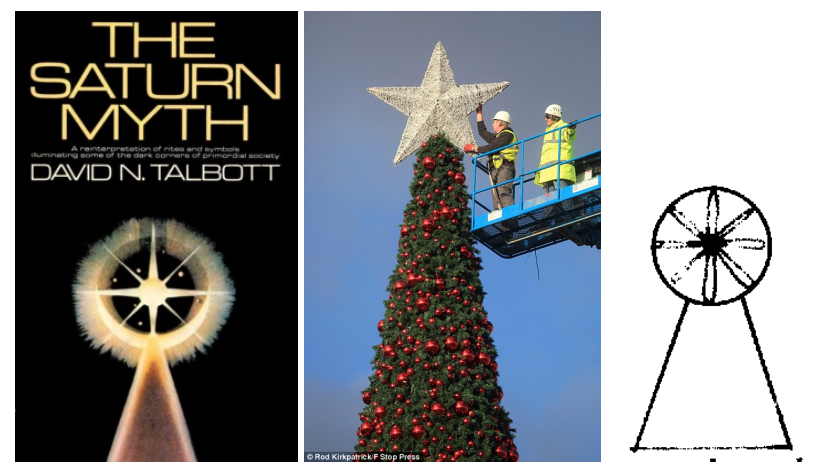
Today these symbols and rituals are ‘continued’ through the focus of ‘mass’ media, ‘mass consumption’ and the ‘ethereal effect’ of the ‘lack of light’ that we ‘take in’ at Saturnalia. It has become Christmass hypnosis. And the official religions of ancient Rome have now become the religions of ‘buying things’. Shopping malls are the cathedrals decorated to the hilt with neon lights. Even as far away as Australia, where if we went back several thousands years, the Aboriginal people would not have heard of such ceremonies and pagan rituals. It’s all a ‘programme’ that has spread ‘world wide’ with good reason. Saturn’s influence over humanity is through ‘hypnosis and the connection to what we call ‘time’ and the ‘unseen’.
The Hunt, Pan & the Gingerbread Man
As I have already said, Ancient Rome was the epicentre of Saturnalia. The cities architectural symbols, not least the ‘phallic symbol’ or Obelisk relating to the ‘death’ and ‘resurrection’ of the Egyptian god Osiris (Orion) can be found placed in the Capitols of Europe. They are there to invoke the ‘sexual’ masculine energy, or the ‘randy old goat’ syndrome also known as the god Pan. Old Pan is connected to the myths associated with the Lord of Capricorn (Sex magic) and the Lord of Aquarius (Electronic Communications) through Mercury.

The worship of Pan began in Arcadia (Greece), which was always the principal seat of his worship. Arcadia was a district of mountain people, culturally separated from other Greeks. The hunt, the Shepard, the cave and the woods where all abodes of Pan. Hermes (Mercury) was considered the great grandfather of Pan. Symbolically Mercury goes ‘between’ worlds and is the messenger of what we the Romans called the gods. These gods are ‘personified energetic realms’ and it has become clear to me that the imagery and symbols associated with ‘the gods’ are portals into that ‘energetic field’. Hermes, as the father/grandfather of Pan connects Pan (the goat) with the titan Saturn in Capricorn. The Gävle Goat (Swedish: Gävlebocken) is a traditional Christmas display erected annually at Slottstorget in central Gävle, Sweden (below). It is a giant version of a traditional Swedish Yule Goat figure (Pan) made of straw, which often is attacked by arsonists during Saturnalia.
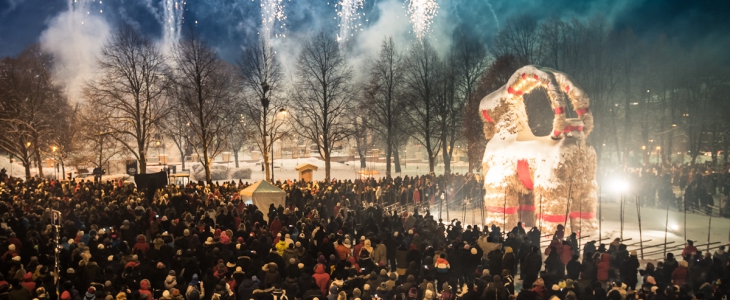
Saturnalia is also a time for family visits, trips and all communication (electrical or otherwise) especially over the festival period. Mercury is currently retrograde this December 2016, so watch out!
Catch me if you can?
Saturnalia as recorded by the Greek writer poet and historian Lucian (in his dialogue entitled Saturnalia) observes the festivals in his time. Lucian mentions human sacrifice, ‘widespread intoxication’, ‘going from house to house while singing naked’, ‘violation’ and other ‘sexual activities’. He also mentions consuming human-shaped biscuits (still produced in some English and most German bakeries during the Christmas season as the gingerbread man). “You can’t catch me!” takes on another meaning when you consider the deeper meanings behind Saturnalia and the horrors some might have suffered at that time. There is another side to Christmas that invokes both the ‘good and the bad’, where children become the focus for this tussle. Chitty Chitty Bang Bang and Hansel and Gretel (with the ginger bread house) come to mind! I’ll come to Krampus too shortly.
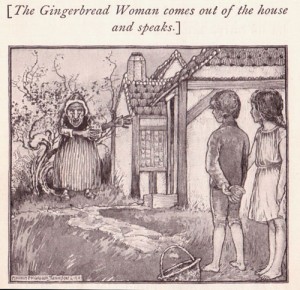
We Three Kings from Orion are …
In previous blogs I have pointed out the connection to three belt stars of Orion (Alnitak, Alnilam and Mintaka) and the pyramids of Giza – not to mention the Hopi’s Three Mesas of Arizona. Many myths are allegories of the path of the sun through the signs of the zodiac, and the famous axiom ‘As above and so below’ is so true. The word ‘Orient’ in the Christmas carol We Three Kings from Orient Are’ should be replaced by ‘Orion’. The three Magi who searched for the newly born Christ are symbolic of the three stars in the hunter’s belt in the constellation of Orion.

Egyptians also knew Orion as ‘the father of the ‘First Time’ of Osiris (as Adam/Ptah) and the Egyptian trinity also connect to Orion. The Three Kings represent the three divine aspects of Will, Love and Intelligence in some sources. The name ‘Orion’ literally means ‘the breaking forth of light’ and therefore symbolizes the ‘place of light’. I feel that ‘place’ is where Saturn gets its ‘interstellar instructions’. In some South American cultures Orion’s Belt is known as ‘Las Tres Marias’ (The Three Marys) in honour of Mary of Nazareth, Mary Magdalene, and Mary of Bethany. One od the first Christmas cards I made was of Mary and Josepth (Isis and Osiris) being visted by an alien loosely based around the song ‘A Spaceman Came Travelling’ by Chris De Burgh.
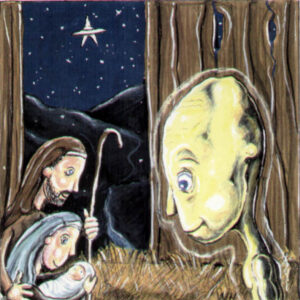
Born in a Cave
Kronos (Saturn) as I mentioned above was the Sun in the cave and it is said in myth that his mother Rhea carried Kronos ‘the stone’ wrapped in swaddling clothes, as though he were the babe to which she had given birth. The Babe in a manger born among animals (not least the Ass and Ox) in a stable or a cave and wrapped in swaddling clothes was common in many ancient religions. The mother of Kronos in the Hindu myth equivalent was known as Chaya, meaning ‘shadow’. She represented the unconscious, other-worldly, the unseen and the light of the aura. You could see her as the Queen of the fairies (fairy lights). In a small an intriguing book called The Greatness of Saturn, by Dr Robert E Svoboda (below), that covers Eastern Vedic myth, Chaya is represented as ‘material things’, the illusion of the material life and how the shadow allows this ‘fake light’ to be seen for what it is – illusory.
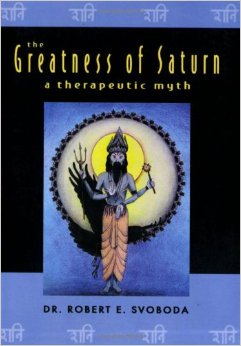
The Gnostics also talk of the ‘light of Christos’ and its penetration of the dark, the shadow world (see my other blogs here)
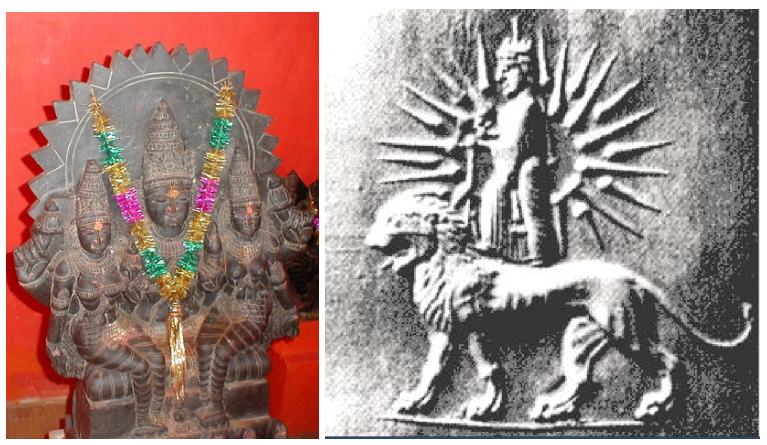
According to legend, Hermes was also born in a cave on Mount Cyllene in Arcadia (see Pan and Mercury above). Zeus had impregnated Maia at night while all the other gods slept. When Hermes was born at dawn (like the Sun), Maia wrapped him in swaddling clothes. The Roman version of Jesus (before Jesus) Mithras, was also born in a cave, with shepherds in attendance, all on the 25th of December. Mithras was known to his followers as ‘The light of the world,’ or ‘The Good Shepherd,’ and urged his followers to share ritual communion of bread and wine. Mithras’s priests were called ‘Father.’ Add the word ‘Christmas’ after ‘father’ and there you have it.
Krampus (Santa’s Claws) – Sakwa Hu
Krampus, the horned, anthropomorphic folklore figure described as ‘half-goat, half-demon’, is another symbolic deviation of Pan. Santa or Saint Nick in Nordic and Germanic versions can be often seen together. They are two halves of the same symbol.
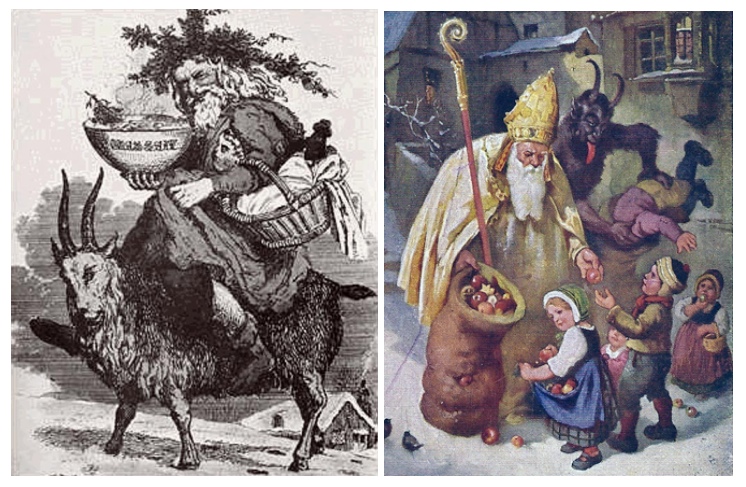
During the Christmas season, Krampus punishes children, just like the Hopi Kachina Sakwa Hu, who arrives at the winter solstice or Soyal (Soyalang-eu) to do the same? A group of about thirty “official” kachinas, called Mong Kachinas, takes part in five major ceremonies held during this period: Soyalang-eu (Winter Solstice Ceremony) in December, Pamuya in January, when the sun appears to move north again. During Soyal, which lasts nine days of what we call Christmas, sacred rituals are performed in chambers, called kivas, and many ceremonies involving dancing and singing take place; the kachinas may even bring gifts to the children. And the Christian’s think its all about Jesus, you have to laugh really.
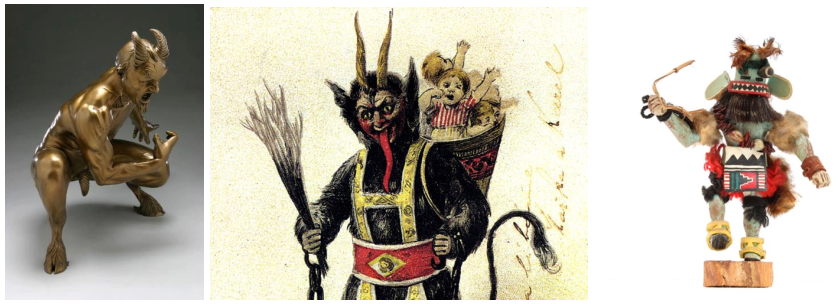
Soyal time is when stories are passed down to children from the elders and children are taught pivotal lessons like respecting others. The Hopi believe that everything that will occur during the year is arranged at Soyal (New Year Resolutions as such). Children are also given replicas of the kachinas (dolls), intricately carved and dressed like the dancers, to help them learn about the hundreds of kachina spirits. Sixteen days before the winter solstice, one of the chief kachinas enters the house. He appears as a tired, old man who has just awakened from a deep slumber, teetering and on the verge of losing his balance. Santa is so old he’s loosing it! The Hopi god Masauwu (see my other blogs on Orion) is massively connected to the symbols of Orion, Saturn and Father Time (see below).

Cottontail was a symbol for both the ‘hare’ and ‘time’. Interestingly, the hare was said to be a ‘child of Pan’ and in many myths she (the Hare) was wrapped in goats skin. Of course the ‘hare’ and the ‘Moon’ are symbolically connected in much folklore and the hare also takes on the role of a ‘demiurge’ in some myths. See an interesting book called The Lady of the Hare by John Layard. The constellation of Lepus runs alongside Orion and there is more to know about this connection.
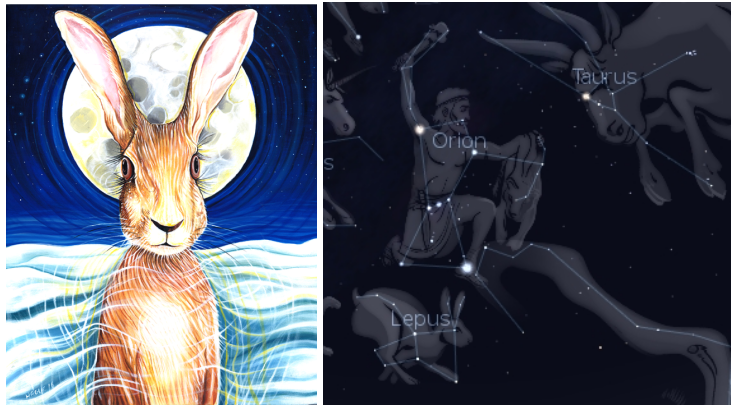
Krampus is also another version of Ba’al Hammon, the Carthaginian god who was regarded as the counterpart of the Roman Saturn and Greek Cronus. Krampus is one of the companions of Saint Nicholas in regions including Austria, Bavaria, Croatia, Czech Republic, Hungary, Slovenia and Northern Italy. The song Santa Claus is Coming to Town is based on the Germanic pagan folk tales of Krampus
He sees you when you’re sleeping’
He knows when you’re a wake
He knows if you’ve been bad or good
So be good for goodness sake…
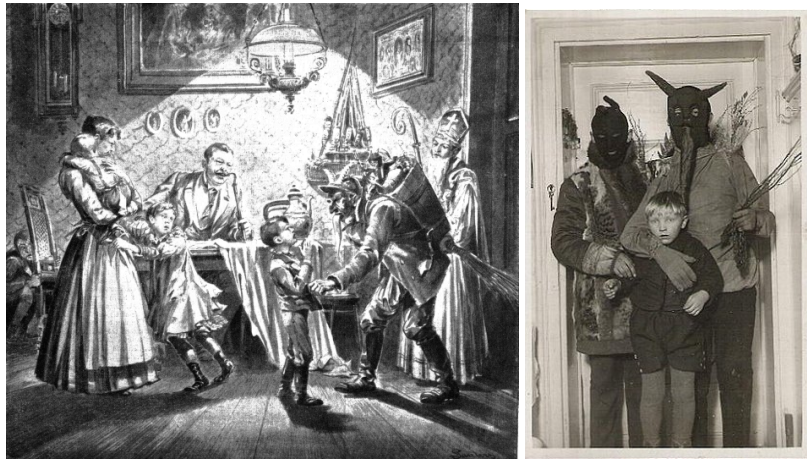
Santa Cronos
The modern figure of Santa Claus (Saint Nicholas, Saint Nick, Father Christmas, Kris Kringle) is derived from the Dutch figure of Sinterklaas, whose name is a dialectal pronunciation of Saint Nicholas, the historical Greek bishop and gift-giver of Myra. During the Christianization of Germanic Europe, this figure may have absorbed elements of the god Odin, who was associated with the Germanic pagan midwinter event of Yule and led the ‘wild hunt’, a ghostly procession through the sky. Of course the hunter Orion is observed clearly in the winter sky from November through to the Winter solstice, along with the constellations of Sirius and Lepus. The winged serpents in the image below infer a Hermes connection to Saturn.
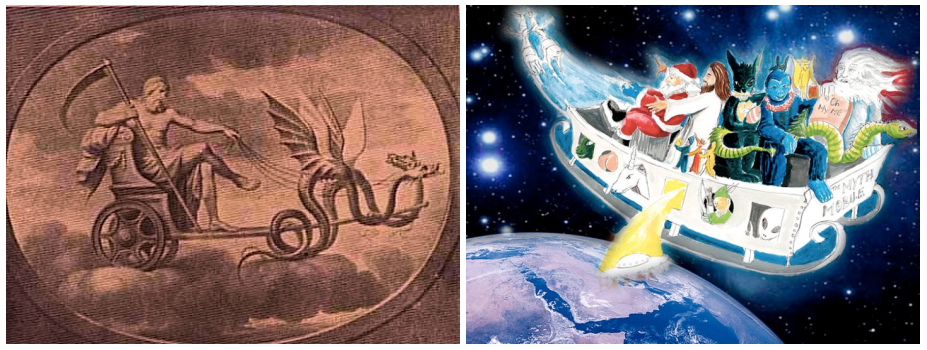
Telling a child that Santa, (who is essentially an old bloke, a stranger with magical powers), who sneaks into your house to leave gifts, in the child’s early years, is creepy enough. But to then say it was all a fib later on, is the power of Ba-humbug; and we have all partaken in this myth making. The creeping around at night while children sleep is harmless to those from loving families, but consider the amount of ‘creeping around’ in orphanages and children homes over the years by figures that are more like Krampus? Saturnalia is a time of year when both the good and the bad are magnified ‘energetically’.
‘Coke’, Magic Mushrooms and Flying Reindeer
In his book Mushrooms and Mankind (The Book Tree, 2003) the late author James Arthur points out that Amanita muscaria mushroom (below), also known as fly agaric, lives throughout the Northern Hemisphere under conifers and birch trees, with which the fungi (which is deep red with white flecks) has a symbiotic relationship. Some say that this explains the practice of the Christmas tree, and the placement of bright red-and-white presents underneath, which look like Amanita mushrooms. Arthur wrote.
“Why do people bring pine trees into their houses at the Winter Solstice, placing brightly coloured (red and white) packages under their boughs, as gifts to show their love for each other…?” he wrote. “It is because, underneath the pine bough is the exact location where one would find this ‘Most Sacred’ substance, the Amanita muscaria, in the wild.”
I would suggest that it has more to do with Saturn’s pole position in that Golden Age mentioned earlier, but there maybe some truth in this across certain cultures.
Reindeer are common in Siberia, and seek out these hallucinogenic fungi. Donald Pfister, a biologist who studies fungi at Harvard University, suggests that Siberian tribesmen who ingested fly agaric may have hallucinated into thinking that reindeer were flying. The use of ‘red and white’ for Christmas and Santa is clearly connected to the Coca Cola imagery and their 20th Century campaign to associate Saturnalia with this drink.

The Time of the King of Saturnalia
The King of Saturn ruled as the ’master of ceremonies’ for the proceedings through Saturnalia. He was appointed by lot, and has been compared to the medieval Lord of Misrule at the Feast of Fools. In England, the Lord of Misrule (known in Scotland as the Abbot of Unreason and in France as the Prince des Sots) was an officer appointed to preside over the Feast of Fools (below).
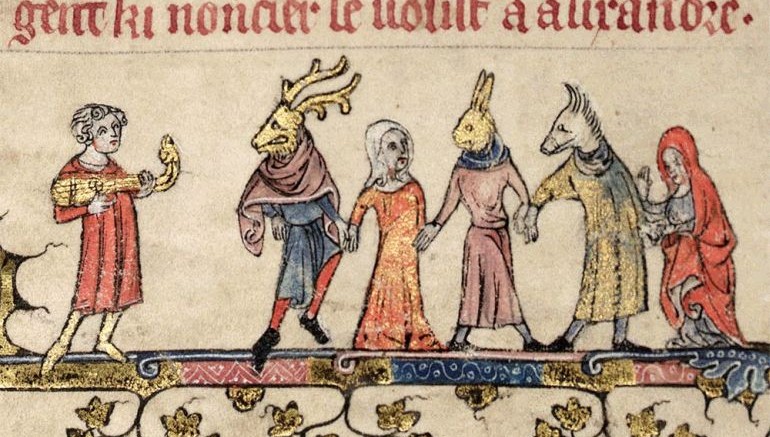
The Lord of Misrule was generally a peasant or sub-deacon appointed to be in charge of Christmas revelries, which often included drunkenness and ‘wild partying’, in the pagan tradition of Saturnalia. Sunds like every town in the UK to me? The Roman emperor Nero played the role of Saturnalia in his youth. Where as the first emperor Augustus celebrated the ‘Golden Age of Saturn’ it was eventually lost.
Saturnalia and misrule makes a ‘mockery of a world’ in which law was determined by one man and the traditional social and political networks are reduced to the power of the emperor over his subjects. In general terms, Saturnalia was the celebration of the longing for Saturn to reign again, as in ancient times. The donkey or Ass was another symbol of misrule and ‘mockery of law and order’, ‘title and kingship’. In Ancient Egypt Seth, the enemy of Osiris (his brother) had the image of a donkey. That’s why Apuleius in his Golden Ass describes a great metamorphosis, the transformation of Lucius to a donkey and his way back – spiritual evolution towards the human being. Jesus also was said to ride into Jerusalem on a donkey (see below).
In this case donkey represents sexuality, instincts, sensuality, ignorance. A red donkey was said to be one of the dangerous creatures that the soul met in its journey after death – possibly an archon of sorts? The Ass and the Lord of Misrule go together at both Saturnalia (Christmas) and Ostara (Easter).
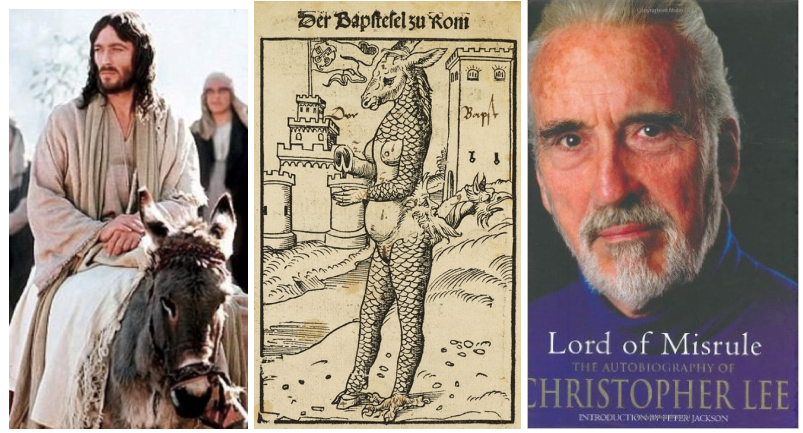
According to the anthropologist James Frazer in his book The New Golden Bough, he says there was a darker side [and the rest] to the Saturnalia festival. In Durostorum on the Danube (modern Silistra), Roman soldiers would choose a man from among them to be the Lord of Misrule for thirty days. At the end of those thirty days, his throat was cut on the altar of Saturn. Similar origins of the British Lord of Misrule, as a ‘sacrificial king’ (a temporary king, as Frazer puts it) who was later put to death for the benefit of all, have also been recorded. See the movie The Wicker Man starring the late Lord of Misrule himself – Christopher lee (above). I once stood next to Lee at a Euro star waiting area over a decade ago and he seemed a very ‘strange’ man to me.
The sordid and sinister rituals that are hinted at in the Kubrick movie Eye’s Wide Shut also happen at Christmas (see below). Note the Sun (Saturn) Star featuring in the Illuminati-style Elite parties early on in the film. Sex is a big part of Saturnalia and of course it plays a big part in Kubricks film too.

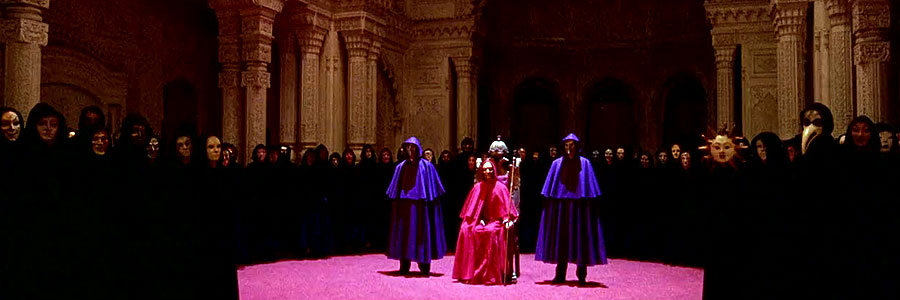
Father Time Magazine
The infamous American Time Magazine, which was created by Henry Luce, a member of Alpha Delta Phi and Skull and Bones secret society, is another example of the subtle symbolism of Saturnalia ‘end of year celebration’. As I have shown, Chronos is usually portrayed as an older, wise man with a long, grey beard, similar to ‘Father Time’. Both the ‘father figure’ aspect can suffice in terms of symbolism, and in other years from ‘time to time, more obvious imagery sums up the connection to Saturn through, death, royalty, the Moon and ‘hidden worlds’ (space). Just look at some of the covers of Time Magazine?

Some of the current English words whose etymological root is khronos/chronos include ‘chronology’, chronometer, chronic, anachronism, and chronicle. The Time Magazine is the Chronicle with its cover of the Person of the Year ‘in December’. No mattter where you look, its ”Saturn everywhere’, especially at Saturnalia.
Saturnalia’s Slaves & Masters
The phrase Saturnalia was also a characteristic shout or ’salutation’ of the festival, in Roman times. The ’Yo ho ho’ is connected to this Salutation. Seneca looked forward to the holiday of Saturn, if somewhat tentatively, in a letter to a friend:
“It is now the month of December, when the greatest part of the city is in a bustle. Loose reins are given to public dissipation; everywhere you may hear the sound of great preparations, as if there were some real difference between the days devoted to Saturn and those for transacting business. & Were you here, I would willingly confer with you as to the plan of our conduct; whether we should eve in our usual way, or, to avoid singularity, both take a better supper and throw off the toga.”
Roman Microbius also writes in his work titled Saturnalia.
“Meanwhile the head of the slave household, whose responsibility it was to offer sacrifice to the Penates, to manage the provisions and to direct the activities of the domestic servants, came to tell his master that the household had feasted according to the annual ritual custom. For at this festival, in houses that keep to proper religious usage, they first of all honor the slaves with a dinner prepared as if for the master; and only afterwards is the table set again for the head of the household. So, then, the chief slave came in to announce the time of dinner and to summon the masters to the table.”
That’s your Christmas dinner! I am sure some people feel like a slave when it comes to cooking?
Back then a suckling pig was sacrificed (and still is eaten in large quantities in more Latin, Hispanic countries). The Turkey replaced the ‘pig’ over the centuries, unless you were munching on flesh in Tudor times, you might have a combination of both ‘sown together’ as a ‘cockenthrice’, just one of the many twists of Saturnalia. How lovely!
Roman Saturnalia is best-known for roles reversal and behavioral license, which allowed slaves to act like masters and visa versa. Roman slaves were treated to a banquet of the kind usually enjoyed by their masters. Role-playing was implicit in the Saturnalia’s status reversals, and there are hints of mask-wearing or ’guising’. The Elite families would have loved all that role play, hunting in masks and genrally playing roles reversed? maybe they did and still do? Slaves were set free just for the festivities… So ‘nothing’s changed then?’ See every Bank Holiday too. Who is it that rules over the banking system? Saturn! Who owns the banks? The Elite familes that adore Saturnalia.
Versnel writes in Saturnus and the Saturnalia;
“Gambling and dice-playing, normally prohibited or at least frowned upon, were permitted for all, ’even slaves’. Coins and nuts were the stakes. On the Calendar of Philocalus, the Saturnalia is represented by a man wearing a fur-trimmed coat next to a table with dice, and a caption reading: “Now you have license, slave, to game with your master.” Rampant overeating and drunkenness became the rule, and a sober person the exception.”
Yeah, your allowed to feel free for a week or so, to drink (be merry) and pretend that you’re not a ‘slave to the system’!

Some things change, some things don’t
In his many poems about the Saturnalia, the poet Marcus Valerius Martialis names both expensive and quite cheap gifts, including writing tablets, dice, knucklebones, moneyboxes, combs, toothpicks, a hat, a hunting knife, an axe, various lamps, balls, perfumes, pipes, a pig, a sausage, a parrot, tables, cups, spoons, items of clothing, statues, masks, books, and pets. Writing today he would be mentioning ‘Pound Land’ and ‘unwanted socks’ too! In ancient Rome gifts might be as costly such as a ‘slave’ or ‘exotic animal’, but Martialis suggests that ‘token gifts’ of low intrinsic value inversely measure the high quality of a friendship. You were being judged by the gift you gave? Patrons or ‘bosses’ might pass along a gratuity (sigillaricium) to their poorer clients or dependents to help them buy gifts. A ‘Christmas bonus’ for some, and ‘bugger all’ for others like today? Some emperors were noted for their devoted observance of the Sigillaria (19th December), when small pottery gifts were given. Some say that the giving of Christmas cards came from Sigillaria in Ancient Rome?
I wrote this blog not to focus on the darkness of Saturnalia but to simply say that if people wish to really make a change and want to really ‘vibrate’ to a ‘higher level’, we may just have to ‘come away from the ‘same old rituals’, programmes and polarised views that are tucked away within all of the ‘Christmas razzamatazz’. Symbols, icons, stories and legends are more powerful than we can imagine. We are still in ancient Rome (and Egypt) in so many ways, as these rituals and festivals have been with us since then. I would prefer to focus on ‘introspection’ at this time of year (which is hard when you have small children I know), but whatever you do, make sure you can get out of the ‘Saturn vibe’, even if its just for an hour or two, to contemplate the ‘bigger picture’ beyond the claws of Saturnalia.
Peace on Earth (while you can).
Neil
